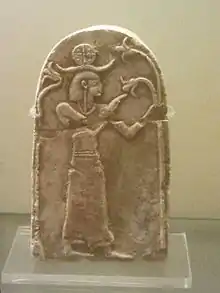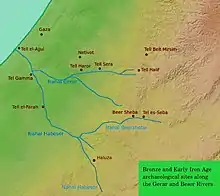Tell Beit Mirsim
Tell Beit Mirsim est un site archéologue d'Israël situé à la frontière entre la Shéphélah et le Mont Hebron.

| Pays | |
|---|---|
| Coordonnées |
31° 27′ N, 34° 55′ E |
| Statut |
|---|
| Direction des fouilles |
|---|



Histoire
Le site est exploré en 1926, 1928, 1930 et 1932 par William Foxwell Albright[1], parfois accompagné de Nelson Glueck[2]. Il s'agit d'un exemple caractéristique d'une ville du royaume de Juda à l'exemple de Beit Shemesh, Tell en-Nasbeh (en), Khirbet Qeiyafa et Beer-Sheva : un mur de casemates a été construit sur tous ces sites et les maisons de la ville proche ont incorporé les casemates comme l'une des pièces de l'habitation. Ce modèle n'est connu d'aucun site cananéen, philistin ou du royaume d'Israël. Lors des fouilles Albright découvre deux fragments d'anses de jarres portant l'inscription hébraïque « l˒lyqm n˓r ywkn » qui signifie « à Eliakim serviteur de Yokin »[3]
Albright identifie le site avec la ville biblique de Débir mais cette identification n'est pas acceptée par la communauté archéologique, Rabud (en) étant considéré comme l'emplacement le plus probable[4].
Notes et références
- W. F. Albright, The Fourth Joint Campaign of Excavation at Tell Beit Mirsim, Bulletin of the American Schools of Oriental Research no 47, octobre 1932, p. 3-17
- Ève Gran-Aymerich, Les chercheurs de passé, Éditions du CNRS, 2007, p. 832-833
- William Foxwell Albright, The Fourth Joint Campaign of Excavation at Tell Beit Mirsim, Bulletin of the American Schools of Oriental Research, numéro 47, pages 3 à 17, octobre 1932.
- Trevor Bryce, The Routledge Handbook of the Peoples and Places of Ancient Western Asia: From the Early Bronze Age to the Fall of the Persian Empire, Taylor & Francis, 2009, p. 588
Bibliographie
- C.R. Conder et H.H. Kitchener, The Survey of Western Palestine: Memoirs of the Topography, Orography, Hydrography, and Archaeology, vol. 3, Londres, Committee of the Palestine Exploration Fund, (lire en ligne) (pp. 279, 290)
- Sa‘ar Ganor, Shifra Weiss et Emil Aladjem, Tell Beit Mirsim (South), Hadashot Arkheologiyot – Excavations and Surveys in Israel, (lire en ligne), chap. 131
- Miki Ein Gedy et Karni Golan, Tell Beit Mirsim, Hadashot Arkheologiyot – Excavations and Surveys in Israel, (lire en ligne), chap. 119
- V. Guérin, Description Géographique Historique et Archéologique de la Palestine, vol. 1: Judee, pt. 2, Paris, L'Imprimerie Nationale, (lire en ligne) (p. 349)
- E. H. Palmer, The Survey of Western Palestine: Arabic and English Name Lists Collected During the Survey by Lieutenants Conder and Kitchener, R. E. Transliterated and Explained by E.H. Palmer, Committee of the Palestine Exploration Fund, (lire en ligne) (p. 379)
Liens externes
- Portail de l’archéologie
- Portail d’Israël